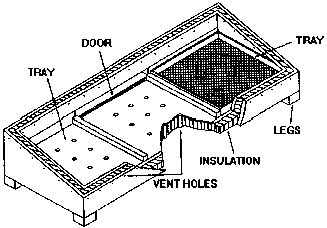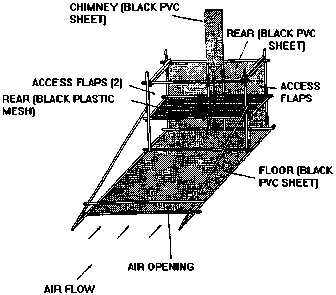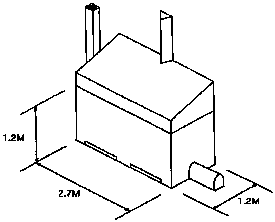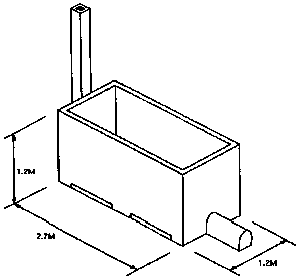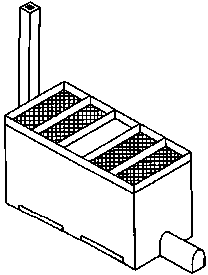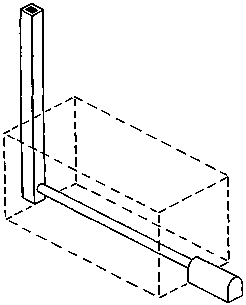Difference between revisions of "How to Dry Chillies"
Ozlemayan1 (talk | contribs) (→Drying) |
|||
| (27 intermediate revisions by 7 users not shown) | |||
| Line 1: | Line 1: | ||
=Drying of Chillies - Technical Brief= | =Drying of Chillies - Technical Brief= | ||
| − | + | ==Short Description== | |
| + | *'''Problem:''' Drying chillies as a small business | ||
| + | *'''Information Type:''' Application / | ||
| + | *'''Difficulty:''' Difficult | ||
| + | *'''How Many people?''' Up to 5 people | ||
==Harvesting== | ==Harvesting== | ||
| Line 41: | Line 45: | ||
<center> | <center> | ||
| − | [[Image: | + | [[Image:Chillies02.gif]]<br /> Figure 2: The 'Exell Solar Dryer' |
</center> | </center> | ||
| Line 57: | Line 61: | ||
<center> | <center> | ||
| − | [[Image: | + | [[Image:Chillies03.gif]]<br /> Figure 3 A combined wood burning and solar drier |
</center><center> | </center><center> | ||
| − | [[Image: | + | [[Image:Chillies04.gif]]<br /> Figure 4 |
</center><center> | </center><center> | ||
| − | [[Image: | + | [[Image:Chillies05.gif]]<br /> Figure 5 |
</center><center> | </center><center> | ||
| − | [[Image: | + | [[Image:Chillies06.gif]]<br /> Figure 6 |
</center> | </center> | ||
| Line 99: | Line 103: | ||
<div class="booktext"> | <div class="booktext"> | ||
| − | There are many manual grinders that could be used to grind chillie (see equipment suppliers | + | There are many manual grinders that could be used to grind chillie (see equipment suppliers at [[How to Process Spice]]). |
An experienced operator can grind about 20kg in an eight hour day. However, this is hard and boring work. A treadle or bicycle could easily be attached to the grinder which will make the work easier. With this system one person could grind about 30kg in one day. | An experienced operator can grind about 20kg in an eight hour day. However, this is hard and boring work. A treadle or bicycle could easily be attached to the grinder which will make the work easier. With this system one person could grind about 30kg in one day. | ||
| Line 164: | Line 168: | ||
''Solar drying'' Practical Action Technical Brief | ''Solar drying'' Practical Action Technical Brief | ||
| + | ==Related Articles== | ||
| + | *[[How to Preserve Food with Small Scale Drying Technologies]] | ||
| + | *[[How to Preserve Food by Drying]] | ||
| + | *[[How to Use Sun Power]] | ||
| + | *[[How to Make Chocolate]] | ||
| + | *[[How to Preserve Tomato]] | ||
| + | *[[How to Preserve Food with a Solar Dryer]] | ||
| + | *[[How to Process Spice]] | ||
| + | *[[How to Process Turmeric]] | ||
| + | *[[How to Build a Tray Dryer]] | ||
| + | *[[The Anagi Tray Dryer]] | ||
| + | *[[How to Dry Chillies]] | ||
| + | *[[How to Process Pepper]] | ||
| − | + | ==Equipment suppliers== | |
Note: This is a selective list of suppliers and does not imply ITDG endorsement''.'' | Note: This is a selective list of suppliers and does not imply ITDG endorsement''.'' | ||
| − | + | ===Drying Equipment=== | |
Bombay Industrial Engineers 430 Hind<br /> Rajasthan Centre<br /> D.S. Phalke Road<br /> Dadar (C.Rly.)<br /> Mumbai - 400 014<br /> Maharashtra<br /> India<br /> Tel: +91 (0)22 2411 39 99 / 2411 42 75<br /> Tray, tunnel, drum and fluid bed driers are available. | Bombay Industrial Engineers 430 Hind<br /> Rajasthan Centre<br /> D.S. Phalke Road<br /> Dadar (C.Rly.)<br /> Mumbai - 400 014<br /> Maharashtra<br /> India<br /> Tel: +91 (0)22 2411 39 99 / 2411 42 75<br /> Tray, tunnel, drum and fluid bed driers are available. | ||
| Line 188: | Line 205: | ||
Bay Hiap Thai Company Ltd Wernakorn<br /> Kasem, Bangkok<br /> Wernakorn Kasem,<br /> Bangkok<br /> Thailand<br /> Tel: +66 2 2212432 / 2213670<br /> Dried Chilli Roasting Machine 50 kg/hour<br /> Gas powered | Bay Hiap Thai Company Ltd Wernakorn<br /> Kasem, Bangkok<br /> Wernakorn Kasem,<br /> Bangkok<br /> Thailand<br /> Tel: +66 2 2212432 / 2213670<br /> Dried Chilli Roasting Machine 50 kg/hour<br /> Gas powered | ||
| + | ==Contact== | ||
| + | '''Practical Action, The Schumacher Centre for Technology & Development'''<br />'''Bourton Hall, Bourton-on-Dunsmore, Rugby, Warwickshire CV23 9QZ, UK'''<br />'''Tel: +44 (0)1926 634400 Fax: +44 (0)1926 634401 E-mail: [mailto:Infoserv@practicalaction.org.uk Infoserv@practicalaction.org.uk] Web: http://www.practicalaction.org'''<br />'''Intermediate Technology Development Group Ltd Patron HRH -The Prlnce of Wales. KG, KT, GCB'''<br />'''Company Rag. No 871954, England Rag. Charity No 247257 VAT No 241 5154 92'''<br /> | ||
| + | |||
| + | |||
| + | '''This Howtopedia entry was derived from the Practical Action Technical Brief ''Drying of Chillies''. <br />To look at the original document follow this link: | ||
| + | http://www.practicalaction.org/?id=technical_briefs_food_processing | ||
| + | |||
| + | ==Categories== | ||
| + | [[Category:Agriculture]] [[Category:Energy]] [[Category:Equipment Design]] [[Category:Food Processing]] [[Category:Products]] [[Category:Resource Management]] [[Category:Small Business]] [[Category:Sun]] [[Category:Easy to Medium]] | ||
| + | |||
| + | [[Category:Monsoon Climate]] [[Category:Montaneous Environment]] [[Category:Rural Environment]][[Category:Tropical Climate]] | ||
| + | |||
| − | + | [[Category:Bricks]] | |
| + | [[Category:Cardboard]] [[Category:Clay]] [[Category:Cement]] [[Category:Chillies]] [[Category:Glass]] [[Category:Up to 5 Persons]] | ||
| − | + | [[Category:Household]] [[Category:Village]] | |
| + | |||
| + | [[Category:Application]] [[Category:Howtopedia requested drawings]] [[Category:Howtopedia requested images]] | ||
| + | [[Category:Practical Action Update]] | ||
| + | [[Category:Requested translation to Spanish]] | ||
| − | + | [[fr:Comment sécher les piments]] | |
| − | |||
| − | |||
| − | |||
| − | [[ | ||
| − | |||
| − | |||
| − | |||
| − | |||
| − | |||
| − | |||
| − | |||
| − | |||
| − | |||
| − | |||
| − | |||
| − | |||
| − | |||
| − | |||
| − | |||
| − | |||
| − | |||
| − | |||
| − | |||
Latest revision as of 16:46, 29 July 2014
Contents
- 1 Drying of Chillies - Technical Brief
Drying of Chillies - Technical Brief
Short Description
- Problem: Drying chillies as a small business
- Information Type: Application /
- Difficulty: Difficult
- How Many people? Up to 5 people
Harvesting
By definition 'processing' does not involve harvesting. However, one cannot produce a good quality product from badly harvested materials. Correct harvesting techniques could be said to be the most important factor in the production of a high quality final product.
For processing, chillies should not be picked until it starts going red.
Cleaning
The crop should be cleaned before processing. The first stage is to remove dust and dirt using a winnowing basket. This can be made locally from bamboo, palm or other leaves. Someone used to this work can remove the dust, dirt and stones quickly and efficiently (eg they could clean 100kg of chillies in an eight hour day). Small machines are available for cleaning but they are rarely cost effective.
After winnowing the crop needs to be washed in water, all that is needed are two or three 15 litre buckets. For larger quantities a 1m³ sink/basin with a plughole needs to be constructed. This can be made out of concrete. However, the water must be changed regularly to prevent recontamination by dirty water. Only potable water should be used.
Drying
This is by far the most important section in the process. The inability to adequately dry the produce will, at the very least slow down the whole process and possibly lead to mould growth or discolouration. Any produce with even a trace of mould cannot be used for processing. The sale value of mouldy chilli can be less than 50% the normal value. In extreme cases the whole crop can be lost.
Drying during the dry season
During the dry season, sun drying is usually adequate to dry the produce. The simplest and cheapest method is to lay the produce on mats in the sun. However, there are problems associated with this method. Dust and dirt are blown onto the crop and unexpected rain storms can re-wet the crop.
A solar dryer avoids these problems. The simplest type is the cabinet solar dryer, see Figure 1, which can be constructed out of locally available materials (eg bamboo, coir fibre or nylon weave).
For larger units (over 30kg/day an 'Exell Solar Dryer' could be used, see Figure 2. However, the construction costs are greater and a full financial evaluation should therefore be made to ensure that a higher income from better quality spices can justify the additional expense.
Drying during the wet season
During the wet season or times of high humidity, which often coincides with the harvest of the spices, a solar dryer or sun drying can not be used effectively.
An artificial dryer, which uses a cheap energy source is necessary. This may be a wood or husk burning dryer or a combined wood burning and solar dryer. Figures 3-6 show a combined wood burning and solar drier which is based on the McDowell Dryer and has been used in Sri Lanka.
Over drying
Care needs to be taken to prevent over drying of the crops. A drier operator will soon learn how to assess the moisture content of the crops by hand. The final moisture content should be 10% wet basis.
Grading
In some cases the crop needs to be graded, eg high quality packaged products. Chillie is graded by colour and size this is done by hand. The brighter the colour red the better.
Grinding
Grinding may also add value but must be done carefully as there are difficulties. A whole, intact product can be easily assessed for quality whereas a ground product is more difficult. There is a market resistance to ground produce due to fear of adulteration. This can only be overcome by producing a consistently high quality product and gaining the confidence of customers. There are basically two types of grinders - manual grinders and mechanical grinders. A grinding mill has to be placed in a separate and well-ventilated room because of dust.
Manual grinding mills
There are many manual grinders that could be used to grind chillie (see equipment suppliers at How to Process Spice).
An experienced operator can grind about 20kg in an eight hour day. However, this is hard and boring work. A treadle or bicycle could easily be attached to the grinder which will make the work easier. With this system one person could grind about 30kg in one day.
Work needs to be done to find out the degree of fineness the consumer wants. The grinding mills then need to be set so that they produce the desired ground product.
For small-scale production, (up to 100kg/day) a series of these grinders is all that is needed. For larger scale production units, a mechanical grinder would be required.
Mechanical grinding mills
Horizontal plate, vertical plate or hammer mills are suitable for grinding chillies. A grinding mill has to be placed in a separate and well-ventilated room because of the dust.
As above the grinding mill needs to be adjusted so that it grinds the chillies to the desired fineness.
Packaging
Packaging material
Packaging of these products, especially if they are ground requires polypropylene. Polythene cannot be used as the flavour components diffuse through it.
Simple sealing
The bags can be sealed simply by folding the polypropylene over a hacksaw blade and drawing it slowly over the flame of a candle. However, this is extremely uncomfortable as the hacksaw blade heats up and burns the hands of the operator. However, this is a very common technique.
Sealing machines
A sealing machine will speed this operation up considerably and produce a much tidier finish (which is very important).
The cheapest sealing machines have no timing mechanism to show when the bag is sealed and they have a tendency to overheat.
Sealing machines with timers are desirable. The machines come in many sizes. For most work an 8 inch (20cm) sealer is sufficient. Eye catching labels should be sealed above the product in a separate compartment and holed so the package can be hung-up in the shop.
Storage
A well designed and secure store is essential.
The optimal conditions for a store are: low temperature, low humidity and free from pests. The store should be located in a shaded, dry place. To keep humidity as low as possible only fully dried products should be stored in it. The produce should be checked regularly and if it has absorbed too much moisture it should be dried again.
To prevent pests entering, the roof should be completely sealed. Mosquito netting should be placed over the windows and doors should be close fitting.
References and further reading
Small-scale spice processing, Practical Action Technical Brief
Drying technologies, Practical Action Technical Brief
Drying of foods Practical Action Technical Brief
Solar drying Practical Action Technical Brief
Related Articles
- How to Preserve Food with Small Scale Drying Technologies
- How to Preserve Food by Drying
- How to Use Sun Power
- How to Make Chocolate
- How to Preserve Tomato
- How to Preserve Food with a Solar Dryer
- How to Process Spice
- How to Process Turmeric
- How to Build a Tray Dryer
- The Anagi Tray Dryer
- How to Dry Chillies
- How to Process Pepper
Equipment suppliers
Note: This is a selective list of suppliers and does not imply ITDG endorsement.
Drying Equipment
Bombay Industrial Engineers 430 Hind
Rajasthan Centre
D.S. Phalke Road
Dadar (C.Rly.)
Mumbai - 400 014
Maharashtra
India
Tel: +91 (0)22 2411 39 99 / 2411 42 75
Tray, tunnel, drum and fluid bed driers are available.
Udaya Industries Uda Aludeniya
Weligalla
Gampola
Sri Lanka
Tel: +94 8 388586
Fax: +94 8 388909
Multi purpose dryers available for a wide range of food and agricultural products including; Cereals, Fruit, Herbs, spices, Vegetables.
Ashoka Industries Kirama
Walgammulla
Sri Lanka
Tel: +94 71 764725
The dryer uses paddy husk or saw dust as fuel. Capacity: 15-75 kg/10 hours
|
Sealing machinesDoboy Limited |
Bay Hiap Thai Company Ltd Wernakorn
Kasem, Bangkok
Wernakorn Kasem,
Bangkok
Thailand
Tel: +66 2 2212432 / 2213670
Dried Chilli Roasting Machine 50 kg/hour
Gas powered
Contact
Practical Action, The Schumacher Centre for Technology & Development
Bourton Hall, Bourton-on-Dunsmore, Rugby, Warwickshire CV23 9QZ, UK
Tel: +44 (0)1926 634400 Fax: +44 (0)1926 634401 E-mail: Infoserv@practicalaction.org.uk Web: http://www.practicalaction.org
Intermediate Technology Development Group Ltd Patron HRH -The Prlnce of Wales. KG, KT, GCB
Company Rag. No 871954, England Rag. Charity No 247257 VAT No 241 5154 92
This Howtopedia entry was derived from the Practical Action Technical Brief Drying of Chillies.
To look at the original document follow this link:
http://www.practicalaction.org/?id=technical_briefs_food_processing
Categories
- Agriculture
- Energy
- Equipment Design
- Food Processing
- Products
- Resource Management
- Small Business
- Sun
- Easy to Medium
- Monsoon Climate
- Montaneous Environment
- Rural Environment
- Tropical Climate
- Bricks
- Cardboard
- Clay
- Cement
- Chillies
- Glass
- Up to 5 Persons
- Household
- Village
- Application
- Howtopedia requested drawings
- Howtopedia requested images
- Practical Action Update
- Requested translation to Spanish
